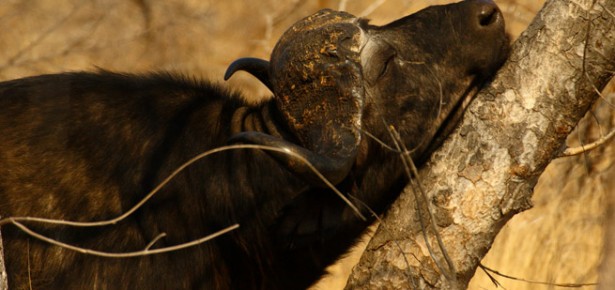
Cape Buffalo. Photo: Mario Melletti.
When I was five-six years old my father used to take me seeing bulls of domestic cattle breeds and I was impressed by these huge animals.
By the time my passion was strengthened and when I became an adult I had a chance to work on forest buffalo in the Congo Basin. During that time, I was surprised how little information was available on this species and I began to study the ecology and behaviour of this buffalo that become my PhD and then the basic idea of this volume.
At first I thought to write a book on African forest buffalo but I realized that such a work would not have been possible with the limited data available. My idea changed when I realized to include all wild cattle species and to make this work much more comprehensive.
“Twelve of the thirteen species of Bovini are threatened, one is already extinct (aurochs) and another is possibly extinct, the kouprey in Southeast Asia”
When I proposed this title to the Cambridge University Press, I knew there were no other books that summarized the most important aspects of the ecology, evolution, conservation status and management of this amazing group of species and I was a bit surprised for that.
Monograph books existed on American bison and African buffalo but not a comprehensive volume about all wild cattle species. So I have taken this opportunity and the project was well accepted by the Cambridge Press.
Then I built up, with my co-editor James Burton, an international team of experts coming from more than 20 countries spread in five Continents and this was of crucial importance for the success of this book.
Even the illustration section was a long process that lasted 18 months to be drawn considering that each species was illustrated in colour and in black and white by three Italian artists.
The large amount of work was due to the coordination of more than 70 experts and lasted almost four years to complete the volume.
The book is characterized by three main aspects:
Wild cattle play a very important role in the present day societies although most people overlook this group of animals. The link between these species and humans has existed for thousands of years. Five species of wild cattle have been domesticated in the last seven thousand years. We cannot forget that the current domestic breeds, most of them descendents from one species the extinct aurochs, are spread with millions of individuals in almost every corner of the world. They give us so many benefits if we think to the dairy products only that millions people use and consume every day.
On the other hand, domestic and feral cattle have negatively impacted many ecosystems by overgrazing or completely altering the coastal ecosystems for example in Australia with the feral water buffalo.
Some species (e.g. domestic water buffalo) have been used as draught animals for thousands of years and still continue to be used in developing countries in India and Southeast Asia. For example, wild cattle are also utilized to improve the genetic, heath and adaptation of some domestic forms so they are also significant as genetic pool.
These species are adapted to very different environments, if we take in consideration the small forest buffalo living in the rainforest of the Congo Basin or the anoa, the smallest wild cattle species, in the Sulawesi Island or on the other extreme the wild yak adapted to cold climate at high altitudes in the Tibet Plateau.
Unfortunately the declining conservation status of many wild cattle species shows the pressures they face and highlights the urgent need for greater effective conservation action. Twelve of the thirteen species of Bovini are threatened, one is already extinct (aurochs) and another is possibly extinct, the kouprey in Southeast Asia. Yet, the enigmatic saola was the most amazing zoological discovery in 20th century. This species when was discovered in 1992 in Vietnam was already extremely threatened by illegal hunting and we know almost nothing on the ecology, biology and population trend.
Finally, we hope that this volume makes a contribution towards the conservation and management of wild cattle and their habitats and raises the profile of these species to a wider readership because they deserve this kind of consideration.
Latest Comments
Have your say!